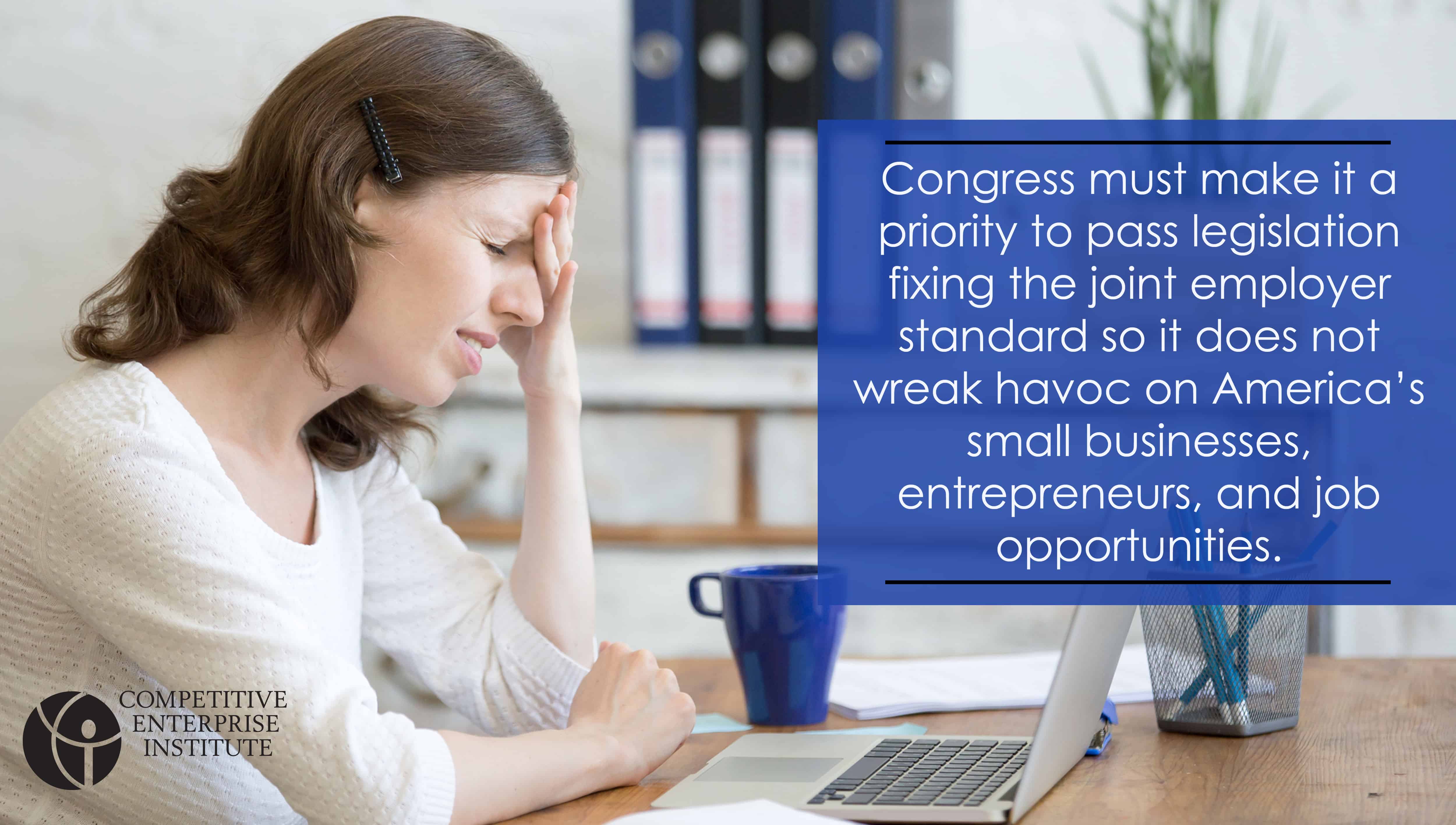
What is a joint employer in American labor law?
A joint employer is a business in a contractual relationship in which two or more businesses possess control and responsibility over certain employees. The two businesses share control and supervision of those employees, such as when two or more employers exert direct control over workplace practices like hiring and firing, setting wages, and other essential conditions of employment.

What changes did the National Labor Relations Board make to the joint employer standard?
In August 2015, the National Labor Relations Board (NLRB), the federal agency charged with regulating U.S. private sector labor relations, abruptly changed the longstanding rules for determining when businesses would be considered joint employers, overturning 30 years of precedent. In an unfair labor practice complaint brought against waste management company Browning-Ferris Industries by the International Brotherhood of Teamsters, the NLRB invented a new, vague, and overly broad definition of joint employer.
Under the new standard, a company may be held liable for labor violations by other employers with which they contract, by 1) merely exercising indirect control over essential terms and conditions of employment or 2) having “unexercised reserved control,” whereby an employer may contractually possess the authority to control certain work conditions, but never actually exercises that authority. Previously, employers could depend on a bright-line and easily understood joint employer standard: one employer had to exercise direct and immediate control over another company’s workforce. In simple terms, one business had the authority to hire or fire the other businesses’ employees.
By contrast, the new joint employer standard is extremely unclear. When the Browning-Ferris case was argued before the U.S. Court of Appeals for the D.C. Circuit on March 9, 2017, Judge Patricia Millett questioned whether the NLRB, using its own analysis, could determine the difference between a legitimate joint employer relationship and a contractor relationship. In fact, no one in court that day seemed to be able to grasp what the NLRB meant by “indirect” control. Nor has the NLRB done anything to clarify what it means to be a joint employer in the two years since its Browning-Ferris decision.
How does the NLRB’s joint employer standard impact small businesses?
The new joint employer standard leaves job creators with anxiety over what workplace policies may trigger joint employer designation. Without a bright-line rule, when will an employer be suddenly responsible for all labor law violations and collective bargaining obligations that a contractor or franchisee undertakes? These uncertainties and potential cost liabilities make doing business more expensive and complex and thus harms opportunities for workers and entrepreneurs.
Small businesses face the brunt of the negative consequences from the vague and broad joint employer standard. Employers will be forced to think twice about providing any assistance to small companies they contract with in order to avoid greater liability. This includes taking down online job posting portals and no longer supplying scheduling software and guidance on employment issues. Among the hardest hit will be franchise businesses, which will have to spend more time and resources on activities for which their franchisor previously offered assistance.
Small businesses will lose out in other important ways. The NLRB’s new joint employer standard would put at risk at least 40,000 small businesses operating in over 75,000 locations. [1]
The new reality is a franchisor can now be dragged into a franchisee’s employment-based legal disputes, causing increased costs for everyone – higher operational costs, greater exposure to litigation, and increased liability insurance premiums.
To avoid becoming entangled in legal disputes, large companies may also steer clear of contracting with small businesses entirely. If this is done on a large scale, many small businesses will lose valuable clients crucial to their existence.
The ruling also takes away many incentives for starting a small business. Entrepreneurs value autonomy and the flexibility of being their own boss. Many franchise owners may see those incentives diminished under the new joint employer standard as franchisors are forced take greater control of franchisee operations to avoid liability.

How does the NLRB’s joint employer standard impact workers?
Dramatically expanding joint employer liability is bad news for workers and job creation. Recent research from the American Action Forum estimates that the broad, vague joint employer standard could result in 1.7 million fewer jobs over the next ten years.
The new liability will disrupt many well-established business practices that over time have fostered job creation. For example, if companies stop hiring contractors and instead have to hire more workers in-house, that will mean a spike in payroll costs, employment-related taxes, legally mandated benefits, and regulatory compliance costs (like tracking workers’ hours). That’s an outcome that leaves all involved worse off than before.
Temporary jobs and resulting career opportunities will also be diminished as companies become reluctant to hire workers via temp agencies. With so many workers using staffing agencies to re-enter the workforce or switch careers, a temp firm often provides on-the-job training and new, marketable skills that open the door to full-time employment.
Entrepreneurs will take a hit, too. Many aspiring entrepreneurs may not have the necessary knowledge or resources to strike out on their own, but through hard work, determination, and assistance from a franchisor parent company—including management best practices, branding, and marketing—they have the opportunity to succeed as franchise business owners. And putting up new barriers to entrepreneurship will have a ripple effect on jobs. After all, small business startups have created 66 percent of net new jobs since the 1970s.
Corporate social responsibility policies and the people they help will be at risk, as well. Due to the vagueness of the NLRB standard, many policies created to help workers may trigger joint employer employment. For example, some employers have required their suppliers to offer a certain amount of paid leave. Such policies may end if they could establish a joint employer relationship.

What will be the impact of the forthcoming NLRB case against Browning-Ferris Industries?
Since the NLRB issued its decision against Browning-Ferris Industries in August of 2015, the case has been appealed to the United States Court of Appeals for the District of Columbia Circuit. On March 9, 2017, the court heard oral argument in the case, and the court is expected to issue a decision in the fall of 2017. However, no matter how the court rules, the only way to permanently restore the commonsense and longstanding definition of joint employer is for Congress to pass legislation.
What can be done to stop unelected bureaucrats from making this major change to labor liability?
Congress must make it a priority to pass legislation fixing the joint employer standard so it does not wreak havoc on America’s small businesses, entrepreneurs, and job opportunities. The House has taken first steps toward making this happen. On July 27, 2017, a bipartisan group of lawmakers introduced the Save Local Business Act (H.R. 3441) to restore the traditional joint employer standard and make the definition of joint employer under the Fair Labor Standards Act consistent with the definition under the National Labor Relations Act. A companion bill still needs to be introduced in the Senate.

Resources
Studies:
- NLRB’s New Joint Employer Standard Threatens Business Formation and Job Creation (2016)
Congress should rein in the labor board’s activism. - Congress Can Protect Workers Using the Power of the Purse (2016)
The appropriations process offers an opportunity to halt burdensome labor regulations that threaten job growth and worker freedom. - Redefining Workers Out of a Job (2016)
The National Labor Relations Board’s New Joint Employer Standard expands liability and eliminates jobs.
Resources for Small Businesses:
By overturning the decades-old joint-employment standard, the NLRB is exposing thousands of businesses to increased costs and liability they cannot afford—many of which are small businesses that are the main source of American jobs.
- Joint Employer Standard an Obsticle to Job Creation and Entrepreneurship (2017)
A House committee is poised to tackle joint employer regulation. - Obama Administration Policy Threatens Youth Job Opportunities (2016)
By altering the franchise model, the joint employer standard will remove the opportunities that provide many first jobs. - Joint Employer Liability Stifles Small Business (2016)
The new joint employer standard is government interference that creates barriers to America’s entrepreneurial spirit. - Feds Threaten the Independence of Small Business Owners (2016)
By considering more large companies and small businesses “joint employers” increases liability on Big Business that makes them less likely to contract with small businesses in the future.
Resources for Congress:
Joint employer and similar policy changes are not an interpretation of existing regulation or statute, but new policy that should be required to go through the rulemaking process.
- Congress Introduces Cure to Job-Killing Joint Employer Standard (2017)
It is of the utmost importance to repeal regulations, like the joint employer rule, that stifle small businesses. - One Year Later the Joint Employer Standard Still Causing Confusion (2016)
Labor regulators have a goal in mind: to make it far more likely that larger businesses are found liable for the labor violations of smaller businesses. - Corporate Social Responsibility Policies May Suffer under “Joint Employer” Standard (2016)
Companies may become wary of adopting supplier codes of conduct if they bring along joint employer liability with it.
[1] According to research by FRANdata, an information and analysis provider to the franchise industry.